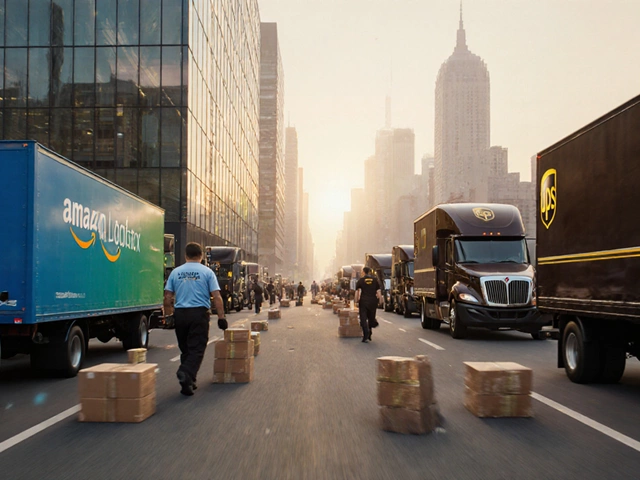Imagine zipping through Toronto traffic, the city skyline a blur in your rearview, parcels stacked in your van, music playing, making way more per hour than your buddies flipping burgers. Being an Amazon driver isn’t just a job—it’s freedom on wheels, plus, let’s face it, you get some serious steps in. But—not everyone gets handed those scanner guns and navy blue vests. Amazon has a checklist, sometimes stricter than your gym’s cancellation policy. If you’re curious about the hoops you’ll have to jump through, grab your notebook (or maybe just your coffee), because some of them will surprise you.
Understanding Amazon Driver Roles: Delivery Partners and Flex Drivers
Amazon splits its driver gigs into two main types: working for a Delivery Service Partner (DSP) or signing up as an Amazon Flex driver. Think of DSP drivers as working for a local company that Amazon hires to handle the heavy lifting (literally). You get a fixed schedule, a company van, and a team structure—kinda like being part of a fast-moving sports team but with parcels, not soccer balls. Flex drivers are basically their own bosses. You drive your own car, set your own schedule, and grab shifts whenever you want through an app—it's like Uber Eats with cardboard boxes. In Toronto in 2025, both options are booming thanks to record online shopping and lightning-fast Prime delivery expectations.
Here’s an quick comparison to help break it down:
| Role | Vehicle | Schedule | Employer | Pay Structure |
|---|---|---|---|---|
| DSP Driver | Amazon or partner van | Fixed, full/part-time | Amazon partner company | Hourly + opportunities for bonuses |
| Flex Driver | Your car (mid-size+) | Flexible, you choose | You (contractor) | Per block, paid weekly |
Now, if you’re drawn to the DSP side, you’ll be expected to handle more packages (up to 200 in a shift!) and cover a specific neighbourhood or zone. There’s a small team feel, even potential for quick career progression—maybe even moving up to supervisor if you’ve got leadership vibes. But if independence is your middle name, Flex lets you say no to morning alarms and yes to booking three-hour rounds right after brunch. Either way, Amazon takes delivery speed seriously and expects you to keep up.
Now, some folks ask if it matters whether you pick one path versus the other. It does. DSP jobs usually come with benefits—think health insurance or paid time off if you’re on for 30+ hours a week—and a well-maintained van. Flex drivers, you’re literally in the driver’s seat with more control, but you cover your car’s wear, gas, and all that paperwork fun.
What Amazon Looks For: Minimum Age, Driving Record, and Legal Documents
The big one: You’ve got to be at least 21 for DSP, 19 if you’re thinking Flex (in most Canadian provinces, including here in Ontario). Age isn't negotiable, and you’ll need a valid Class G license. Amazon isn’t messing around with anyone riding on a permit. For insurance reasons and to protect its reputation, Amazon digs deep into your past driving history—expect a full Motor Vehicle Report check (they want as clean as possible, ideally no major traffic violations or DUIs in at least the last 3-5 years).
Background checks come next. Amazon checks for recent criminal charges, theft convictions, or violence charges—anything that might shake customer trust. Minor speeding tickets might not be a deal-breaker, but a bunch of careless driving offenses will send your application straight to the digital trash.
Paperwork, of course, is heavy. For DSPs and Flex, you’ll need:
- Government-issued photo ID (driver's license—front and back photos, uploaded digitally)
- Proof of work eligibility (birth certificate, permanent resident card, or SIN, and work permit for non-citizens)
- Bank info (for direct deposit payments—forget waiting for paper cheques)
- If you're a Flex driver, proof of insurance in your name, showing appropriate coverage, and vehicle registration details
A funny thing: It’s common knowledge among Toronto Amazon drivers that some local background checks can get bottlenecked—especially during hiring rushes like the winter holidays. Patience helps, but double-check your docs before uploading. If you mess up a photo (blurry or with a glare), Amazon’s system will bounce you back, so take your time.
Amazon will also check your eligibility to work in Canada. That means international students can sometimes take Flex shifts if their study permit allows, but they’ll need to keep those hour caps in mind.

Physical and Tech Demands: It's More Than Just Driving
Yeah, most people just picture the driving part, but Amazon expects serious stamina. There’s a physical fitness assessment for DSP driver candidates—think carrying packages up to 50 lbs (about 23 kg) repeatedly, in all weather. You’ll learn the hard way that Toronto’s February sidewalks are no joke. Comfortable shoes and layers are your new best friends. Arriving without a duffel bag filled with snacks? Rookie mistake.
Amazon also expects you to master their tech. The days of handwritten slips are gone: every driver gets a smartphone or scanner with Amazon’s delivery app already installed. That’s your lifeline. You have to scan barcodes, upload proof-of-delivery photos (front porch pics, anyone?), and sometimes even send real-time delivery updates. Some DSPs test you on tech basics during onboarding—so if you’re the person who takes ten minutes just to find Airplane Mode, brush up in advance. Familiarize yourself with touchscreen basics and troubleshooting on the go. The delivery app is mostly foolproof, but Bluetooth glitches on a rainy day can throw you off schedule.
Time management is massive. Amazon assigns “routes” packed with houses and businesses along optimized paths. They expect you to work fast and accurate—no misdeliveries. If your GPS dies, you have to pivot fast. Most new hires take a week or two to get their rhythm. Here’s a quick hack: veteran drivers swear by prepping your van’s cargo area before leaving the warehouse, organizing your route stops in the right order. If you don’t, expect to crawl on knees digging for a missing delivery, and every lost minute means a tighter finish.
Stress? It’s real, especially during those flurries when doorsteps disappear under fresh snow and customers track parcels like hockey scores. Some drivers keep earbuds in for music or podcasts, just make sure you don’t miss the customer waving from the window. Hydration matters more than you think, too. Toronto summers get hot and humid.
Tips to Stand Out as an Applicant—and Survive the First Month
If you want an edge over other applicants—because trust me, competition ramps up during high-traffic seasons—focus on the details in your application. Don’t just say you “like driving”; mention your local knowledge (knowing side streets is gold for shaving minutes off your route) and any previous courier, rideshare, or customer-facing work you’ve done. Dropping a quick line about safe driving in Toronto’s wild weather doesn’t hurt either.
Preparing for interviews or onboarding? Dress clean, be on time, and bring copies of your documents, even if you’ve uploaded them—tech fails, and showing up prepared scores points. In the onboarding sessions, ask about the best practices for route planning and van organization. Don’t be shy—Amazon’s trainers notice when you’re engaged, and that helps if there’s a waiting list for the next wave of full-time slots.
- Check your phone daily for Flex app “blocks”—they drop fast, and “early birds” literally get paid more.
- Practice entering buildings securely and handling tricky customer situations (think: barking dogs, weird gate codes, apartment buzzers).
- Keep a change of socks and backup phone charger in your van or car—take it from someone who’s lost both on a rainy Wednesday.
- Connect with current Amazon drivers online (Reddit’s r/AmazonDSPDrivers group is full of real talk and hacks specific to Toronto neighbourhoods).
- Track your earnings with an app or spreadsheet—especially important for Flex, where those car expenses sneak up quickly.
Want a fun stat? According to a 2024 industry report, Amazon delivery drivers in Toronto average $22–$26 per hour (before tips/bonuses) as DSP employees, and Flex drivers who know their way around the city’s shortcuts report pulling in $28+ per hour during peak times. The fastest way to burnout is ignoring your own limits, so use available breaks, stretch, and never fudge safety for speed—Amazon tracks your delivery completion, but safety always wins out, even if the pressure’s on.
The big takeaway? Becoming an Amazon driver is doable if you’ve got a clean license, the right docs, and a no-quit attitude. Forget the stereotype of bored “delivery guys”—the good drivers in 2025 are sharp, organized, adaptable, and quick on their feet, literally. If that feels like you, it might be time to slide into one of those blue vests and test the city’s fastest routes yourself.





